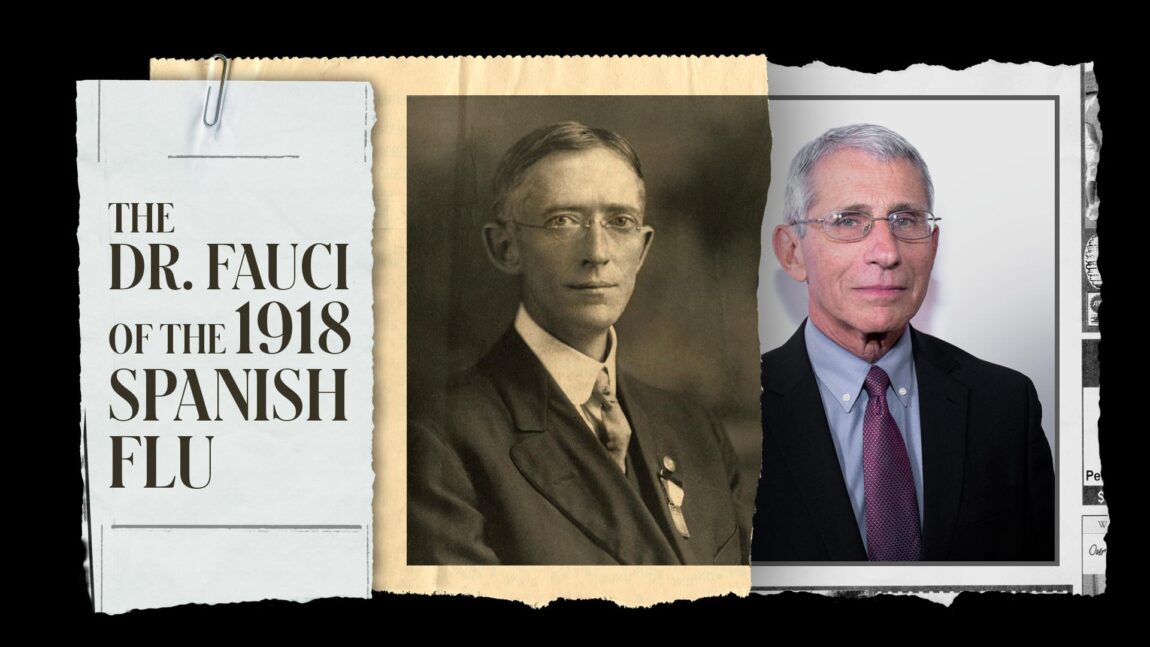In January 1919, Washington’s health commissioner urged legislators in the state capital, Olympia, to enforce strict measures against the spread of the Spanish flu, which had just ended a deadly second wave in America. Recommended restrictions included banning dances and other social gatherings, as well as limits on how many people could attend public meetings and how far apart they should sit from one another. Both the city and county voted against those measures. In response, the commissioner sought to get the State Board of Health to enforce its police powers against the county.
Instead, he lost his job.
A public health official getting fired over unpopular social distancing measures during a pandemic has an eerie echo today, when business leaders and politicians are chafing against restrictions urged by authorities to contain the COVID-19 pandemic. But it was precisely these restrictions that enabled Seattle and other cities in Washington to protect themselves from the Spanish flu—and similar actions helped Kansas abate another influenza wave in the fall of 1919.
At the center of public health efforts in both states was a practical, plainspoken, bespectacled scientist: Dr. Thomas Dyer Tuttle, who became a powerful, if polarizing, figure in the fight against the Spanish flu—not unlike Dr. Anthony Fauci is perceived today, in the battle against COVID-19.
Apart from the passing physical resemblance, both Dr. Tuttle and Dr. Fauci fought global pandemics late in their long public health careers and the perilous balance of science and sociology that entails. Both men attended Ivy League medical schools. Both were commissioned officers in the United States Public Health Service. And both had experience fighting previous epidemics. Fauci first came to prominence in the 1980s as the leading HIV/AIDS researcher for Ronald Reagan and George H.W. Bush. For Tuttle, it was a resurgence of smallpox at the turn of the 20th century.
Tuttle was born in Fulton, Missouri, in 1869. He was the son of a grocer who had married into wealth—his mother’s family, according to a local history, had a home encompassing about a quarter of a city block. He received his bachelor’s degree at local Westminster College (where Winston Churchill would deliver his famous “Iron Curtain” speech some 56 years after Dr. Tuttle had graduated). Tuttle then moved to New York City in 1889 to obtain a medical degree at what was then known as Columbia College.
During that first year of medical school, he unwittingly found himself in the midst of one of the deadliest flu pandemics, the so-called “Russian flu,” which had killed tens of thousands in Europe that fall and arrived in New York in December. That flu would end up causing more than 2,500 deaths in New York before subsiding in February 1890.
Battle Ready in 1918: Soldiers under quarantine in Washington state during the Spanish flu and Red Cross volunteers sewing masks. (Washington State Historical Society, Gregg Courtwright Collection)
After graduating from Columbia in 1892, Tuttle worked at New York’s Mount Sinai hospital. He later returned to Missouri, where he married his wife, Lucile, in 1896. A few years later, the couple moved to Montana where Tuttle pursued a medical career and became Secretary and Executive Officer of the state’s Board of Health in 1903.
It was in this role that Dr. Tuttle first learned to value science over unpopular public opinion. In 1909, Tuttle made headlines in local Montana newspapers—ironically, by coming out against quarantines—much to the consternation of the public. Smallpox had ravaged the population in the early 1900s, but Dr. Tuttle’s reasoning behind the order was that lifting quarantines would encourage people to vaccinate. (In 1905, the Supreme Court case Jacobson v. Massachusetts upheld states’ authority to require smallpox vaccinations in the interest of public health.) Tuttle and the state’s Board of Health had promoted mandatory smallpox vaccinations by offering them free of charge and by circulating a Tuttle-penned pamphlet touting their benefits. Those instructions included sharp words for the anti-vaxxers of the day:
“It is the firm belief of the author that the most effectual way to rid this country of smallpox would be to give a few months warning, in order that all might have time to be successfully vaccinated,” Dr. Tuttle wrote. “And then let any cases of smallpox that might appear go at large, without disinfection, so that those who would not be vaccinated might have the disease and be done with it. Such a move would result in a radical ‘change of heart’ on the part of many, if not all, ‘anti-vaccinationists.’”
In 1915, with smallpox under control in America, Dr. Tuttle accepted a new position as health commissioner of Washington. Three years later, in July 1918, the Spanish flu reached the state. The first set of infections hit the Army’s Camp Lewis, where more than 300 cases were reported. As summer went on, the number of cases appeared to decline and the “alarm went down,” says historian Gwen Whiting.
But the numbers started to creep up again in September, and public health officials became concerned about a second wave. The state’s Board of Health met in late September specifically to discuss concerns over the flu, and after the meeting Tuttle spoke to a newspaper to warn citizens that the flu would return. Because of limitations on the state Board of Health’s authority, Dr. Tuttle wasn’t able to enforce many orders until November, says Whiting. But he did use his position to encourage local officials to announce stringent measures to contain the pandemic in early October.
Dr. Tuttle, who lived in Seattle, worked closely with the local health commissioner, Dr. J.S. McBride, to manage the trajectory of flu cases. Alarmed by hundreds of hospitalized cases of flu in the nearby Naval training station, Tuttle declared that the Spanish flu had arrived in the city. Both McBride and Seattle’s mayor, Ole Hanson, acted quickly in response—taking advice from Dr. Tuttle.
Thoughts and Prayers: After closing Seattle’s churches in 1918, Mayor Ole Hanson said, “Religion which won’t keep for two weeks is not worth having.”
On October 5, 1918, Mayor Hanson laid out his measures to curb the epidemic in Seattle. “He closed the churches. He shut down public places. They even raised fines for spitting on the sidewalk,” explains Whiting. “You could be fined if you weren’t wearing a mask to get on the streetcar. All of these strict restrictions were put into place in Seattle. And other cities followed suit.”
Meanwhile, Dr. Tuttle took to the newspapers to spread health advice— sending letters to the press statewide, proclaiming that the flu might be prevented from becoming epidemic with “the earnest, conscientious and intelligent help of every citizen of the State” following a now-familiar set of precautions: Don’t sneeze or cough in your hands, keep away from crowds, and stay at home if you have any symptoms.
The Cold War: To warn Kansans of the perils of another Spanish flu wave, Dr. Tuttle took his message to the local papers.
As with the COVID-19 pandemic, the response to Spanish flu in Seattle, Spokane and other Washington cities had parallels across the country. New York, St. Louis and Los Angeles also saw success through the use of austere public health measures, while cities such as San Francisco and Philadelphia were less restrictive and saw increased flu deaths as a result. But those higher mortality rates are also due, in part, because the severe measures simply weren’t popular. Even in Seattle, “there was a lot of protest” over public health restrictions, says Whiting.
Although Dr. Tuttle gave advice to local authorities behind the scenes, he tended to act more pragmatically as the flu progressed. He never issued a statewide lockdown, for example, because the U.S. Surgeon General had advised against it. He also lifted a statewide order to wear masks in public after Armistice Day in November 1918—partly because citizens weren’t adhering to it anyway. The end of World War I also saw an easing of health restrictions in Seattle. But it came at a cost. In early December, the flu came back. Although this time, rather than ban public gatherings, people exposed to influenza were ordered to remain in their homes.
That month, Dr. Tuttle traveled to Chicago for a national conference of the American Public Health Association dedicated to combating the disease, and that meeting appears to have hardened his resolve to be even more aggressive. Tuttle may have been pragmatic earlier in the epidemic, but he began to be more publicly exasperated at the lack of enforcement of public health laws. Tuttle’s frustrations pepper reports he prepared after this period, and he was later described by a contemporary as belonging “to that old-fashioned school of citizens who believe laws and regulations were made to be enforced.”
Such a resolute attitude likely cut short his position as health commissioner in Washington. The restrictions Dr. Tuttle was trying to enforce were “pretty controversial ideas at the time,” says Whiting, “so he made a lot of enemies.”
After being ousted from Washington, Dr. Tuttle moved to Kansas, where he accepted a position as Epidemiologist for the State Board of Health. In that role, he began to fear another influenza epidemic would appear in the state by the fall of 1919 and minced no words in encouraging the public to follow public health guidelines.
“Those who buried their dear ones last winter should certainly lend every effort to prevent others facing a similar loss,” Dr. Tuttle wrote in a Topeka paper on September 11, 1919. He also wrote letters to county health commissioners, urging strict enforcement of quarantines. Though not considered part of the Spanish flu pandemic, Kansas did see a high level of influenza cases in the winter of 1919-20, and Dr. Tuttle did his best to ensure local communities were prepared.
Despite the work he had done to save lives in Washington and Kansas, it’s clear that Tuttle was pessimistic about his country’s ability to prepare for the next pandemic. “As a matter of fact, we know about as little with regard to the etiology and epidemiology of influenza today as we knew two years ago,” he wrote in one report, “and owing to the inclination of our government (city, county, state and national) to provide funds for operating only when sickness is present, and to absolutely cut off any support whatsoever for the study of the epidemiology of the disease after an epidemic has passed, renders it very probable that we will meet our next epidemic (probably 20 or 30 years hence) with as little knowledge of the true nature of the disease as we had when we confronted the epidemic in the fall of 1918.”
Two years later, Tuttle resigned his role in Kansas, citing a need for a bigger salary so he could afford to pay for his son’s college education. In its biennial report, the Board of Health lamented his departure and urged that the legislature increase the salary for the role in order to secure “a man of the quality and training Kansas desires.”
His next job took Dr. Tuttle back to Montana to start a veterans hospital at Fort Harrison, which still exists today. He later moved to Chicago to practice medicine. In 1933, he and his wife retired to San Diego, where Dr. Tuttle spent his golden years gardening—on the 1940 census, he wryly noted his occupation as “orchidist” with an income of zero—before passing away in 1942.
Second Opinions: Like Dr. Tuttle’s stringent measures, Dr. Fauci’s guidelines haven’t always been popular. (Jeremy Hogan/SOPA Images/LightRocket via Getty Images)
Nearly 80 years after Dr. Tuttle’s death, his legacy in fighting pandemics lives on, which might have come as a surprise to him, given the pessimism he expressed in his lifetime. In 2009, a group of researchers wrote a paper comparing existing CDC guidelines on managing pandemics to those developed during the Spanish flu. The paper noted that of all the recommendations, measures Dr. Tuttle promoted—encouraging the closing of public spaces and social distancing—were still relevant in fighting epidemics today. The report even cited findings from the 1918 December meeting Dr. Tuttle attended before insisting on the draconian health measures that got him fired.
One of the coauthors of that 2009 paper?
Dr. Anthony Fauci.
Source: FORBES





